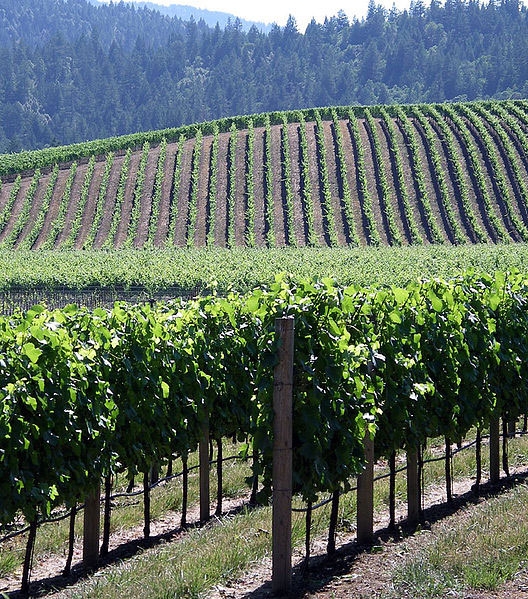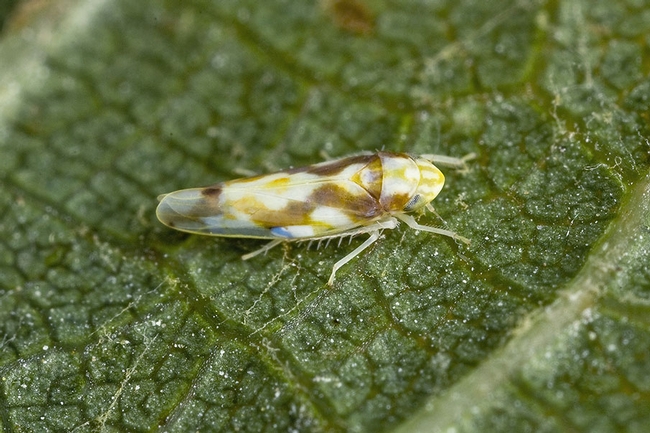Organic farmers are counting on UC to control exotic Virginia creeper leafhoppers
“They lost too much income,” said Glenn McGourty, a UC Agriculture and Natural Resources Cooperative Extension advisor in Lake and Mendocino counties. “They decided they were not going to risk their crop until there is a workable biological control solution to this new pest.”
Meanwhile, other organic grape producers are hanging on to their organic certification and counting on UC ANR researchers to come through with a biological control option soon.
“Organic farmers are spending a couple hundred dollars per acre for organic pesticides,” McGourty said. “They don't want to use them. It takes out beneficial insects and it doesn't even control Virginia creeper leafhopper very well.”
Three leafhopper species are pests of California grapes. Western grape leafhopper is a native insect that's present throughout California north of the Tehachapi Mountains. Several natural enemies keep the pest in check most years. Variegated leafhopper migrated north from the Imperial Valley to Central California in the 1980s, and is established in Napa Valley and other valleys of Napa County. Virginia creeper leafhopper, a native of the northern Midwest, made its way to Northern California in the early 1980s. It migrated southward to the northern Sacramento Valley and Sierra foothills, and most recently was detected in Lake and Mendocino counties, where the population boomed.
“The farmers were devastated, especially financially,” McGourty said. “Conventional growers had to begin spraying pesticides. Some organic vineyards were completely defoliated.”
The leafhoppers' key natural enemies are fairyflies (Genus: Anagrus), among the tiniest flying insects in the world. Certain species of fairyflies attack certain species of leafhoppers. What has scientists perplexed at the moment is the fact that Virginia creeper leafhoppers' natural enemies are present in Mendocino and Lake counties, but they are failing to do their job.
Generally, fairyflies lay their eggs in leafhopper eggs, killing them. The fairyflies known to attack Virginia creeper leafhopper are successfully parasitizing the pest's eggs in Yolo County. However, the very same species of fairyfly is not recognizing Virginia creeper leafhopper eggs as a host in Mendocino and Lake counties.
“Virginia creeper leafhopper only recently moved into the Mendocino area,” said post-doctoral researcher Houston Wilson. Wilson works in the lab of Kent Daane, UC ANR Cooperative Extension specialist based at the UC Kearney Agricultural Research and Extension Center in Parlier. “Although these Anagrus parasitoids can attack both Western grape leafhopper and Virginia creeper leafhopper, the Anagrus population in Mendocino County has been reproducing on Western grape leafhopper for so long, they seem to have lost their preference for Virginia creeper.”
The scientists believe that, in time, fairyflies in Lake and Mendocino counties will begin to parasitize Virginia creeper leafhopper eggs on their own. But, because of the severity of the situation to organic winegrape growers, they've hatched a plan to help out the natural enemies. This summer, they will be rounding up fairyflies in the Davis area – where they know how to attack Virginia creeper – and bring them to Lake and Mendocino county vineyards.
Beginning in April, Wilson will allow Mendocino area Virginia creeper leafhoppers to lay eggs on potted grapevines. The vines will be transported to Davis, where local fairyflies can parasitize the eggs. The plants will go back to the laboratory in Berkeley so scientists can rear populations of the parasitoids and later release them in Mendocino and Lake county vineyards.
“I just planted the grapevines this month,” Wilson said. “When leafhoppers become active in the summer, we'll start monthly releases. We hope our efforts will take some of the pressure off winegrape farmers soon.”
In addition to the work releasing natural enemies of Virginia creeper leafhopper, UC Agriculture and Natural Resources scientists are implementing an area-wide integrated pest management program in Mendocino and Lake counties. The program – a combination of biological, cultural and chemical controls for this pest – employs:
- Improved monitoring and mapping of Virginia creeper populations
- Cultural practices to reduce egg deposition in vineyards
- Earlier and coordinated pesticide applications (if a spray is necessary)
The Virginia creeper leafhopper pest control program is funded in part by the American Vineyard Foundation.
An initiative to manage endemic and invasive pests and diseases is part of UC Agriculture and Natural Resources Strategic Vision 2025.



